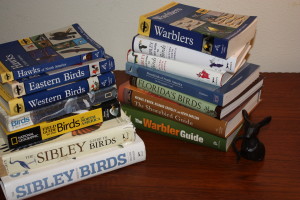Remember the feeling you got as a kid when a Christmas catalog showed up in the mail? That’s how I feel about a good bird book. Time slips away as I flip through page after colorful page, making a mental wish-list of the birds I’d like to see.
In the July 16 post, I recommended two guides to the behavior and natural history of birds. Identifying birds in the field, though, calls for a field guide.
Choosing among the many excellent field guides that are available is largely a matter of taste and habit. I prefer books with illustrations rather than photographs, especially illustrations with arrows or notations that point out distinguishing characteristics and subtle differences between species.
My current favorite is The Sibley Guide to Birds, in part because of its clarity: each page features just one or two species. But I also use National Geographic’s Field Guide to the Birds of North America, the Peterson field guides for eastern and western North America, and the Kaufman Field Guide to Birds of North America. I especially like the smaller books on a long hike, when I don’t want to drag all 2.6 pounds of Sibley around.
On the other hand, portability is only one consideration, because the place to really study a field guide is at home, in a comfortable chair. Compare and contrast the details of various terns, swallows, sparrows, and warblers. Which one has the white forehead? The banded breast? The pink feet? You might not have time to check these details in the field, when the bird is in front of you and your book is behind you, in your backpack.
Ultimately, the quest for the perfect field guide may be irrelevant. Dedicated birders seldom settle for just one book (or two, or three). Visit a book store and flip through the pages. Decide which one feels good in your hands…because that’s where it should spend a lot of time.


